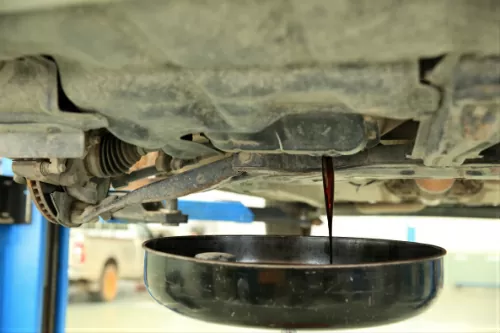What causes black car oil? And when your car oil darkens, does it mean that it’s time to change it? Well, there are a couple of factors that can cause the former. Let’s dig in.
The low-down on factors causing black car oil:
- Heat cycles naturally darken car oil
- Soot causes car oil to turn black
- Car Oil Myth: The colour of the oil indicates when it’s time for an oil change

1. Heat Cycles Naturally Darken Car Oil
During your drive to work in the morning, your engine reaches normal operating temperature (typically 90.6ºC-104ºC), heating the car oil. Then the car oil cools while your car sits in the car park. The process repeats on your way home. And the next day. And the next.
That’s what’s meant by “heat cycles.” The continual exposure to periods of high heat naturally darkens car oil.
Some additives in car oil are more susceptible to darkening in the presence of heat than others. In addition, normal oxidation can darken car oil, too. Oxidation occurs when oxygen molecules interact with oil molecules and cause chemical breakdown, just like how oxygen causes a cut apple to brown or iron to rust. High heat accelerates oxidation.
2. Soot Causes Car Oil to Turn Black


While heat cycles cause car oil to darken, soot causes car oil to turn black. Most people associate soot with diesel engines, but petrol engines can produce soot as well, particularly modern petrol-direct-injection engines.
Soot is a by-product of incomplete combustion. Since soot particles are less than one micron in size, they typically don’t cause engine wear. For comparison, a human hair is roughly 70 microns in diameter.
If soot particles agglomerate into larger wear-causing contaminants, the oil filter will catch them. Sometimes people who use bypass filtration systems, which can filter contaminants down to two microns, express surprise that the car oil is still black. Soot, however, can still elude filtration down to two microns. Any finer filtration and the filter could catch dissolved additives in the car oil.
3. Car Oil Myth: The Colour of The Oil Indicates When It’s Time For An Oil Change
It’s common to assume that black car oil has worn out or become too saturated with contaminants to protect your car engine and requires changing. Not necessarily. As we saw, discoloration is a natural by-product of heat and soot particles, which are too small to wear out your engine.
The only certain way to determine if the oil has reached the end of its service life is to perform oil analysis. Chemically analysing an oil sample reveals the condition of the oil, the presence of contaminants, fuel dilution and so on.
Absent oil analysis, it’s best to follow the oil change recommendation given in your vehicle owner’s manual or by the car oil manufacturer. The recommended service intervals for AMSOIL products, for example, are based on thousands of data points spanning years of use.
It’s best to trust the data, not your eye, in this case. Otherwise, changing the oil could amount to throwing away good oil.

 Europe / English
Europe / English Africa / English
Africa / English France / Français
France / Français Latin America / Español
Latin America / Español India / English
India / English APAC / English
APAC / English US / English
US / English